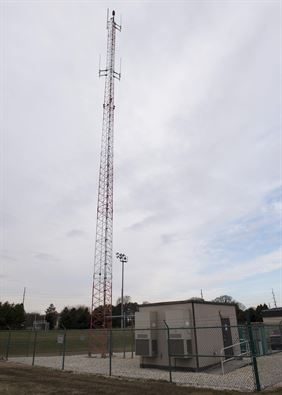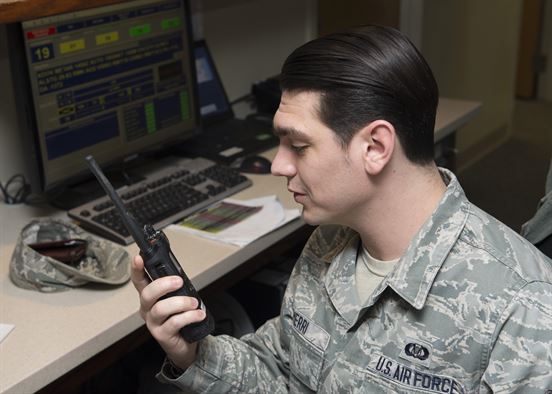Dover Air Force Base – The 436th Communications Squadron upgraded Dover AFB’s trunked land mobile radio system January 2017, according to a Dover Air Force Base spokesman.
 Land mobile radios are commonly used by police officers, firefighters and emergency personnel. The new TLMR system, used by Team Dover first responders, will improve communication reliability, effectiveness and ease of use, while improving the ability to communicate with off-base agencies across the state.
Land mobile radios are commonly used by police officers, firefighters and emergency personnel. The new TLMR system, used by Team Dover first responders, will improve communication reliability, effectiveness and ease of use, while improving the ability to communicate with off-base agencies across the state.
“TLMR is a system that works like a network,” said Staff Sgt. Allen Potter, 436th CS plans and programs coordinator. “We have a single focal point where all our LMRs tie into. This allows them to broadcast out into essentially a giant circle. All the radios within that circle are linked together and are able to communicate together, rather than being limited by line-of-sight or a conventional system where they can only talk point-to-point.”
This upgraded system has increased the reliability of the base’s radio network, compared to the legacy system it replaced.
“The easiest way to think about it is that a conventional system is from one radio to another radio,” said Master Sgt. John Eckert, 436th CS plan and implementations NCO in charge. “It has a very short span in which it will cover, much like a walkie-talkie, but not too far through buildings. This new system added a centerpiece. A signal is transmitted from a radio to the centerpiece, amplifies the signal, allowing it to go farther and penetrate through buildings, to any radio that is on the same channel.”
There are more than 700 of these handheld radios on base. Nearly every unit uses LMRs to accomplish a wide assortment of mission-related communication needs.
According to Potter said it is the base’s first responders who have the most significant impact of this upgrade is the new communication capabilities it affords to first responders.
“The State of Delaware typically uses 800 megahertz radios,” Potter said. “Here on base we use 400 MHz frequency. Our prior models only put out one frequency. With the upgrade to the new radios, we are now able to give our first responders the capability to talk with their counterparts off base.”
The new radio system allowed for interoperability between the on-base and off-base first responders.
“In the past, if they responded to an area that both of them would be at, either the military members or their civilian counterparts would have to trade radios in order for them to communicate between themselves,” Potter said. “Now, with the upgrade, all our personnel have to do is switch over to their channel to talk with them..”
This is not the only upgrade to the system. Now the communication Airmen can update radio encryption and programming wirelessly.
“We added the enterprise system to it,” said Senior Airman Andrew Prout, 436th CS radio frequency transmitting systems. “We are a little hub. We are now able to encrypt radios through this system.”
In the past, communication Airmen would have to go around base physically plugging in radios to encrypt or reprogram them.
“It’s a little bit faster, the biggest one is the over-the-air rekey,” said Eckert. “Before, if a radio lost its encryption key, it wouldn’t be able to be used. But now, if that happens, the user can just simply push a button to re-encrypt it to restore communications.”
Source: Dover Air Force Base
Image Credits: Senior Airman Zachary Cacicia, Dover AFB

